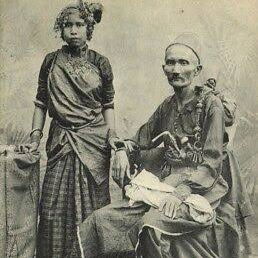Acehnese

ETHNONYMS: Achehnese, Achinese, Atchinese, Atjehnese, Ureung Aceh, Ureung Baroh, Ureung Tunong
Orientation
The Acehnese are a group numbering more than 2.6 million who inhabit the northern portion of the island of Sumatra in Indonesia. They are distinguished from their neighbors primarily by their adherence to the Muslim (Sunni) faith. Acehnese may be divided into two subgroups: the hill people (who are physiologically homogeneous proto-Malays) and the lowland coastal people (who are physiologically heterogeneous). The Acehnese language belongs to the Malay Subfamily of the Indonesian Branch of Austronesian and is most closely related to the Cham languages of Indochina; most Acehnese also speak Bahasa Indonesia.
History and Cultural Relations
Early Acehnese history indicates that it was once ruled by Buddhists who were originally from India. The Sunni Islam religion came to the region probably in the twelfth century, and perhaps earlier. The Acehnese had their first sultan, who controlled a harbor, in the sixteenth century, but it was not until the seventeenth century that the entire area was politically united as a sultanate. The Acehnese resisted colonial European power, which appeared in approximately 1509 and which became prevalent under the Dutch by 1601. The Acehnese did not surrender officially to the Dutch until 1903, and even then resistance continued until World War I. Although declared a part of the new state of Indonesia in 1945, the Acehnese effectively ruled themselves until 1961.
Settlements
Most Acehnese live in villages, also known as meunasah, or prayer houses, since each village contains one or more of these. Villages are located in the midst of the inhabitants' rice fields.
Economy
Most Acehnese subsist through agriculture, primarily by raising rice; in the lowland areas, wet-rice culture is most common, and in the hills, dry-rice culture. Other important crops include sugarcane, tobacco, rubber, peanuts, coconuts, areca, maize, pepper, and, in some areas, coffee. Approximately one-third of the people raising crops do so as sharecroppers, and there are tens of thousands of agricultural laborers as well. Cattle and water buffalo are frequently raised for meat and as draft animals. In coastal areas, Acehnese fish with casting nets, seines, lines, and traps. The Acehnese are well known as metalworkers who fashion weapons as well as goods of gold and silver. Women weave high-quality cotton and silk textiles. Trade is important as a means of bringing cash to the village, and young men are expected to leave the village to trade or work during the first year of marriage.
Kinship
Acehnese kinship terminology is Hawaiian, but it makes sharp distinctions between older and younger kin of the same generation. The nuclear family forms the basic social unit, but society is organized also on a principle of bilateral descent. Patrilineal descent groups are sibs or kawom, of which there are four; they were once a means of security and revenge in times of conflict, but now appear to have lost most or all of their function. Matrilineal descent groups, or karong, function as residential groups among the uxorilocal Acehnese
Marriage and Family
The Acehnese follow Islamic law in marriage prohibition, and they forbid marriage with kin in one's own line of descent or with anyone within three degrees of relatedness. Polygyny still exists among the wealthy. Marriage, which requires the consent of the parents of both bride and groom, takes place after the groom delivers the bride-price to the bride's representatives in the prayer house. Following marriage, the couple lives with the bride's family, and the bride's parents support the bride and her children for a period of time, depending on the size of the bride-price. Inheritance follows Islamic law: for every share given to a female, two are given to a male. Offspring receive inheritance from both parents, with sons receiving agricultural land and daughters dwellings.
Sociopolitical Organization
Although under Indonesian control, the Acehnese also have an elected village chief ( keuchi ) who regulates family law and rice growing, as well as an elected religious authority ( teungku ) who adjudicates matters pertaining to Islamic law. These two officers work together with a village council made up of mature men. Between the village and federal administrative levels is a lower-district level ( mukim ) comprised of those villages that are served by a single mosque; it is administered by a priest ( imeum ). There is also an upper-district level comprised of several villages and mukim; it is governed by an uleebalang. Prior to Indonesian control it had a great deal of autonomy, and the uleebalang office was passed down through patrilineal succession.
Acehnese of the nineteenth century were divided into four separate groups based primarily on religious or governmental function, but these have given way to a division based on whether one is an ulama (religious scholar) or not.
Religion and Expressive Culture
Acehnese are considered among the most zealous of all Indonesians in their Islamic beliefs. They are especially concerned with the pilgrimage to Mecca, the tithe, and the fast during Ramadan. There also survive traditional beliefs in the supernatural, as well as magic associated with agriculture and female shamanism.
Bibliography
Jayawardena, Chandra (1977). "Women and Kinship in Aceh Besar, Northern Sumatra." Ethnology 16:21-38.
Reid, Anthony (1979). The Blood of the People: Revolution and the End of Traditional Rule in Northern Sumatra. Kuala Lumpur: Oxford University Press.
Siegel, James T. (1979). Shadow and Sound: The Historical Thought of a Sumatran People. Chicago: University of Chicago Press.
